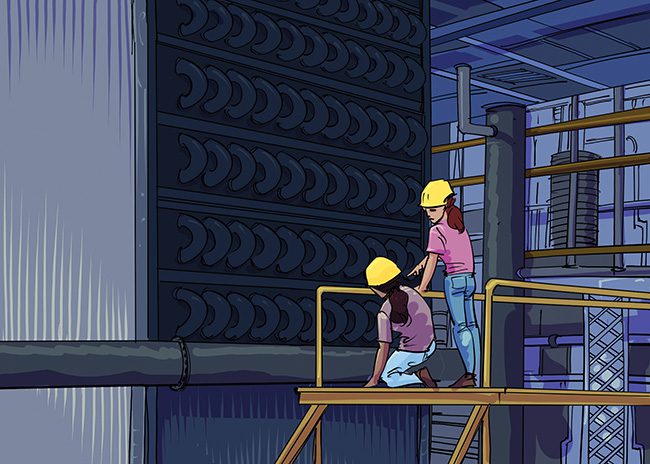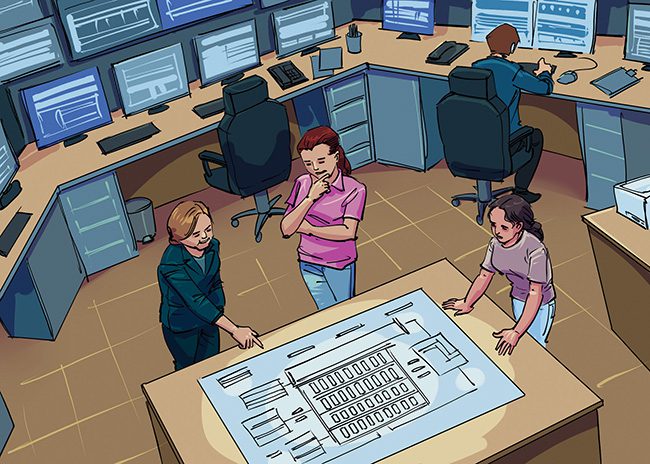Marnie Surfaceblow: Things Change—Pay Attention to the Details
A change in fuel can lead to several other changes in a power plant. Change can be good, except when it’s not. Operators and engineers must be alert to both positive and negative effects, and act to remedy situations before conditions get out of hand.
“We were somewhere around Florence on the edge of the Tuscan highlands, as the jet lag began to take hold.”
“Ma’am?” replied Maya Sharma, lead field engineer of Surfaceblow & Associates International, as she piloted their rented Fiat with frighteningly rapid efficiency through a congested roundabout.
Marnie, Maya’s boss and the vice president of the company, sat in the passenger seat with her eyes closed. “I was paraphrasing Hunter S. Thompson. This west-east jet lag is really … surreal. You’d think eight espressos would wake me up. I saw you reading the project files on the flight here. Any questions?”
Maya deftly zipped around a switchback, revealing the plant stack in the distance. “Aside from ‘Why did we fly economy for 26 hours?’ and ‘Why do you have so much more luggage than usual?’ I wonder why this waste-to-energy facility has so many economizer outlet header tube failures after decades of good operation? It should not be dependent upon the fuel since the failures are external to the gas ductwork.”
“Answer one: We’re doing this job to pay a debt. Answer two: Pass. Answer three: I don’t know—yet.”
Welcome to Italy
To Maya’s surprise, Marnie revealed she was fluent in Italian, making the plant check-in process painless. Noticing her assistant’s surprise, Marnie commented, “Five year ago, I spent a long summer in Italy solving vanadium corrosion problems on some oil-fired boilers. Filthy work, but the scenery was lovely, the food incredible, and … ah … our client approaches. Buon giorno, Liana!”
Uncharacteristically, Marnie ran forward and awkwardly cheek kissed around the tipped-back welding helmet of a short middle-aged woman in plant gear. “Maya, this is Liana Santelli, the welding supervisor and one of my dearest friends!”
Liana and Maya exchanged greetings, then Liana folded her arms and gave Marnie a stern look. “Now, I am one of your dearest friends? You forget; you are here to repay a debt of honor, signora Surfaceblow.”
Marnie winced. “I never forgot the debt; we’re here, aren’t we? Now, let’s go have some coffee while you tell us your story.”
Nonplussed, Liana gave Marnie a fierce look, then shrugged her shoulders and led them to the conference room.
|
Did you miss any Marnie Surfaceblow stories? In POWER’s fictional world, Marnie Surfaceblow is the granddaughter of the late Marmaduke Surfaceblow. We’re placing Marnie, an accomplished professional engineer in her own right, in the role of vice president and lead field engineer for Marmaduke’s firm. We hope you enjoy reading the adventures of Marnie and her sidekick Maya.
Catch up on POWER’s exclusive fictional series here: Oil Pump Amps Provide the Clue Marnie Needs to Stave Off Trouble What Is Killing This Biomass Boiler? Marnie and Maya Are on the Case! Beware of Hissing Feedwater Heaters That Can Bite Your Bottom Line Once an Engineer, Always an Engineer: Don’t Let Technology Hide Simple Problems and Their Solutions |
Economizer Problems
Celestino Rossi, the plant manager, was friendly and effusive in his greetings, as were all the plant staff. The meeting room was ornately paneled, with windows looking down on a vineyard and rolling hills. Celestino began: “We have operated more than 25 years; no problems with the economizer. Suddenly, late summer, the economizer tubes crack at the outlet header. First one, then four, then latest outage, we fix 27. They fail at the weld and it looks like corrosion from bad welding.”
Liana slammed her coffee down. “I know you are thinking; dissimilar metal welding, or poor welds, but there is none. Our welding hasn’t changed since the plant was commissioned. There is lost metal from inside the tubes at the header, meaning you must improve water quality!”
“Our water quality is good. Nothing changed, except you were promoted to welding supervisor last year. And now …” Celestino shrugged. “We cannot operate as planned, and are losing money.”
Marnie held a hand up to stop a retort from Liana and asked, “Nothing has changed in the last year, signore Rossi?”
Celestino shrugged. “This and that. We are a waste facility, and the fuel varies. Different fuels fire differently and the boiler must respond. This is life. We have slagging that comes and goes, but the boiler has all stainless tubing and does very well. There is some erosion from sootblowing on the superheater, but this corrosion is only at the economizer.”
Maya leaned in. “Sir, reviewing your operations data it seems this summer you are having problems meeting your reheat steam temperatures, something that seems unique to this year. Do you know why?”
Celestino nodded. “This spring we started burning waste from local vineyards. It’s much higher in calcium. We have furnace walls that are dirty, but the superheater is very clean. So, we like this fuel because we do not erode the superheater with sootblowing. But, we must bias the split backpass to the reheat side.”
“Yes, I see your damper positions are biased 80% or greater,” replied Maya, “and still you have trouble achieving your reheater target temperatures. But nothing has changed in water treatment or maintenance or repair practices? Is the economizer simply at the end of its life?”
“The plant has cycled frequently through history, but it is a grate-fired boiler and we can keep it running at low power instead of shutting it down. Its lifetime cycles are low. This summer we have run at high output continuously—except when the economizer fails.” Celestino narrowed his eyes at Liana, who returned the glare.
Intervening as only she could, Marnie announced, “I have a question! How do you know the tubes were corroded in the economizer? And do you have economizer sections on both sides of the split backpass? And, if so, are both sections of the economizer experiencing tube failures? And how well has your cooling tower worked this summer? And do you have more coffee?” Marnie finished with a dramatic yawn.
“That is five questions, not one,” answered Liana and Maya in unison, who shared a quick look and a smile. “We know they are corroded because they look corroded,” Liana continued. “There are economizer sections on both sides of the backpass. Only the reheat side experiences failures. The cooling tower has worked well, but struggled under a very hot spring and summer. And, we have more coffee. Would you like me to be your barista perhaps, signora Surfaceblow?”
Marnie smirked. “No need for that last part, dear friend, but I’m seeing a pattern. Show us samples of your failed tubes, and then my faithful assistant and I are going to look through some of your recent data, and I want to talk about welding codes with you.”
Throwing her hands in the air with disbelief, Liana reported, “You? You are going to talk welding codes with me?!? First you fail to repay your debt, then you …”
 |
|
1. Maya and Marnie inspect the economizer. Source: POWER |
Marnie held up a hand. “Please, let us save that battle until after Maya and I fix your economizer [Figure 1]. And then, perhaps you shall be in my debt.”
Liana laughed sharply. “This I must see.”
Old Tubes Provide Answers
Marnie carefully handled cut stainless tubing and asked, “Are these all the tubes you replaced on the economizer header? Maya, what do you think?” Taking out a lighted high-power jeweler’s loupe, Maya scrutinized the ends of the tubes, turning them around and scraping at them with a sharp probe. “These do not look corroded, they look eroded.”
Liana borrowed the loupe, and shook her head. “Eroded? On the inside? By what? Is this why you asked about the cooling tower? Is there debris from it?”
Marnie squinted at the tube ends again. “Noooo … this is erosion of a different sort. Do you see it, Maya?”
Maya paused, silent while her mind traveled down a virtual array of paths, then suddenly she mouthed one word to Marnie, who smiled and nodded. “I must go to your control room to look at your data, now!”
 |
|
2. Liana, Marnie, and Maya review drawings and discuss welding codes. Source: POWER |
“Great! While you do that, my old friend and I will talk welding.” Marnie replied (Figure 2).
“Old friend? I thought I was your dear friend?” Liana scoffed.
“… and not getting any younger,” muttered Marnie.
Steaming in the Wrong Places
In the meeting room with the plant staff assembled, Marnie warmed her hands with an espresso and said, “Maya, why don’t you start.”
Maya stood and addressed the room, starting a PowerPoint presentation showing plant data trends. “My auntie Rohini says, ‘Beware of any change to your recipe, because disaster is one pinch of spice away.’ Meaning any change can unbalance perfection. Here it started with your change in fuel. It shifted your heat transfer so the main steam gains too much heat, and your reheater suffers. But when you send more heat to the reheat side of your split backpass, you are taking extreme measures. And this led to what Ms. Surfaceblow guessed was the problem: Your reheat-side economizer is steaming.”
Marnie sat up and cleared her throat. “I guessed that because I trusted my friend Liana. I knew she was an excellent welder, and also the inlet header tubes had no such problems, nor did the main steam-side economizer, or any other banks. So, I wondered if steam erosion was causing failures at the weakest part—the welds. Detecting that can be difficult on split economizers, but Maya knows how to look for that without me even telling her.”
Maya clicked through several slides of plant data trends, explaining each one. “Like many plants, you do not measure water temperature at each economizer outlet header, only at the furnace lower wall header. But we can see steaming occurs by looking at the drum level. During startup you can have swell or surges as air is forced out or there is localized steaming for brief periods. But, here at full load …” Maya clicked to the next slide, “… you see that the drum level starts to waver, especially when the feedwater temperatures are elevated due to the hot summer and inadequate cooling tower. The steaming ceases once the water from the two economizer sides is mixed to go to the furnace. And with increased slag on the water walls, your drum temperatures are the same despite the extra heat from the economizer.”
After several minutes of discussion and debate, Celestino Rossi asked, “If this is true, what should we do?”
Liana spoke up eagerly. “We can make the header tube connections stronger by switching to full-penetration welds. We have always done partial-penetration welding because it meets the code, takes a third of the time, and is much cheaper, but regaining our lost reliability is worth much more.”
Marnie added, “You can also change your fuel mix to reduce the heat imbalance, or let the reheat temperatures fall and accept some heat rate loss. Or, add new thermocouples and back off load when you get within 10C of steaming, fix your cooling tower, and reduce the economizer water inlet temperature, take a feedwater heater out of service … gosh, what can’t you do? Meet negative change with positive change!”
A Debt Paid
As Liana walked Marnie and Maya to the front gate, she stopped and said, “So, the debt is paid, Marnie. Would you like to try double or nothing? You and me, together, tonight, for 15 touches.”
“Just 10 touches would suit me; we are old enough. I brought all my gear, so get ready to be beaten!” laughed Marnie, hugging her friend quickly, and then walking to the car with Maya.
Shocked to blushing, Maya grabbed Marnie’s arm and whispered quickly, “Ma’am! What on earth are you going to do with that woman tonight?!?”
“Sabre fencing. I lost the last match five years ago and couldn’t pay up. But this time …” ■
—Una Nowling, PE is an adjunct professor of mechanical engineering at the University of Missouri-Kansas City.
